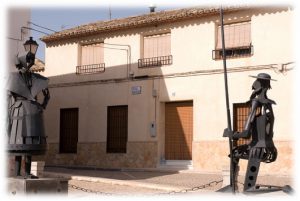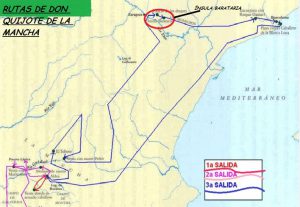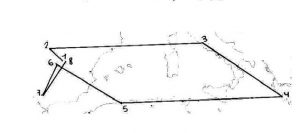Este documente se realizó con motivo del Centenario de Miguel de Cervantes y también para utilizarlo en su realización del Concurso «Cervantes into English», el cual fue premiado en nuestro instituto en distintas modalidades, la Lingüística y la escénica. Todo un honor para nuestros alumnos y para nuestro centro I.E.S «Francisco García Pavón» de Tomelloso (Ciudad Real).
Este proyecto fue elaborado por grupos colaborativos de 1º Bachillerato, modalidad Ciencias Sociales y expuesto delante del resto de sus compañeros para poder ser divulgado y conocido. La mayoría de nuestros alumnos estudian a Cervantes pero esta vez hemos querido dar un paso más adentrándonos en sus distintas rutas y haciéndolo en inglés para fomentar el Bilingüismo y utilizar la lengua inglesa como único vehículo transmisor.
Las competencias que se han trabajado en este proyecto son la Lingüística, Socio Cultural y artística, Aprender a aprender y la Digital principalmente.
Estos proyectos se llevaron a cabo como exposiciones orales para presentar en inglés delante de sus propios compañeros.
1. CASTILLA LA MANCHA
- Section 1: From Toledo to San Clemente by El Toboso.
- Section 2 : From San Clemente to Villanueva de los Infantes by Lagunas de Ruidera, that let us know of the largest lagoons in Spain, also the Cave of Montesinos.
- Section 3: From Villanueva de los Infantes to Almagro and Calatrava.
- Section 4: From the Valle of Alcudia to Campo de Criptana.
- Section 5: From Albacete to Alcaraz.
- Section 6: From La Roda from la Osa de Montiel.
- Section 7: From Campo de Criptana to Tomelloso, Argamasilla de Alba and La Solana.
- Section 8: From Almagro to Toledo by Ciudad Real and Consuegra.
- Section 9: From Esquivias to Illescas and Carranque, this route takes the north of Toledo.
- Section 10: From Río Dulce to Sigüenza and Atienza.
2. BIOGRAPHICAL ITINERARY
 1.Place of birth: Alcalá de Henares, Miguel de Cervantes Cervantes father had a job which was considered to be a low-class one, as they hadn´t much money, they had to move to Valladolid, his second place.
1.Place of birth: Alcalá de Henares, Miguel de Cervantes Cervantes father had a job which was considered to be a low-class one, as they hadn´t much money, they had to move to Valladolid, his second place.
- Valladolid: He studied there in a Catholic school.
- Italy: He was working in Rome as a waiter for a cardinal.
- Lepanto: He left the Pontificial environment for serving as a militar in Lepanto’s battle (1571). He was injured so he decided to come back to Spain but on the way he was kidnapped by turkish corsours, these corsours made him imprisoned in Argel, his next place.
- Argel: He was in prison for 5 years until someone paid his rescue, so he came back to Spain and he wrote La Galatea.
- Toledo: He was married with Catalina de Salazar (1585).
- Sevilla and Granada: He continued with his trips, he worked as a tax collector, but he was tired of this type of jobs so he decided to move to Madrid.
- Madrid: There he wrote his principal artworks (1605), finally he died in Madrid in 1616.
3. THE THREE TRIPS OF DON QUIJOTE
1ST TRIP: Don Quijote is named knight-errant.
2ND TRIP: The different battles, the sheep´s battle and the barber’s battel, he hid in Sierra Morena, Don Quijote did penance, he returned home in a cage, where here niece will take care of him.
3RD TRIP: In La Mancha, he found Dulcinea, the weddings of Camacho, the lions, the Cave of Montesinos, and the illness and death of Don Quijote de la Mancha In Barcelona, the Palace on the way back home.
María Remedios Juanes Silvestre


